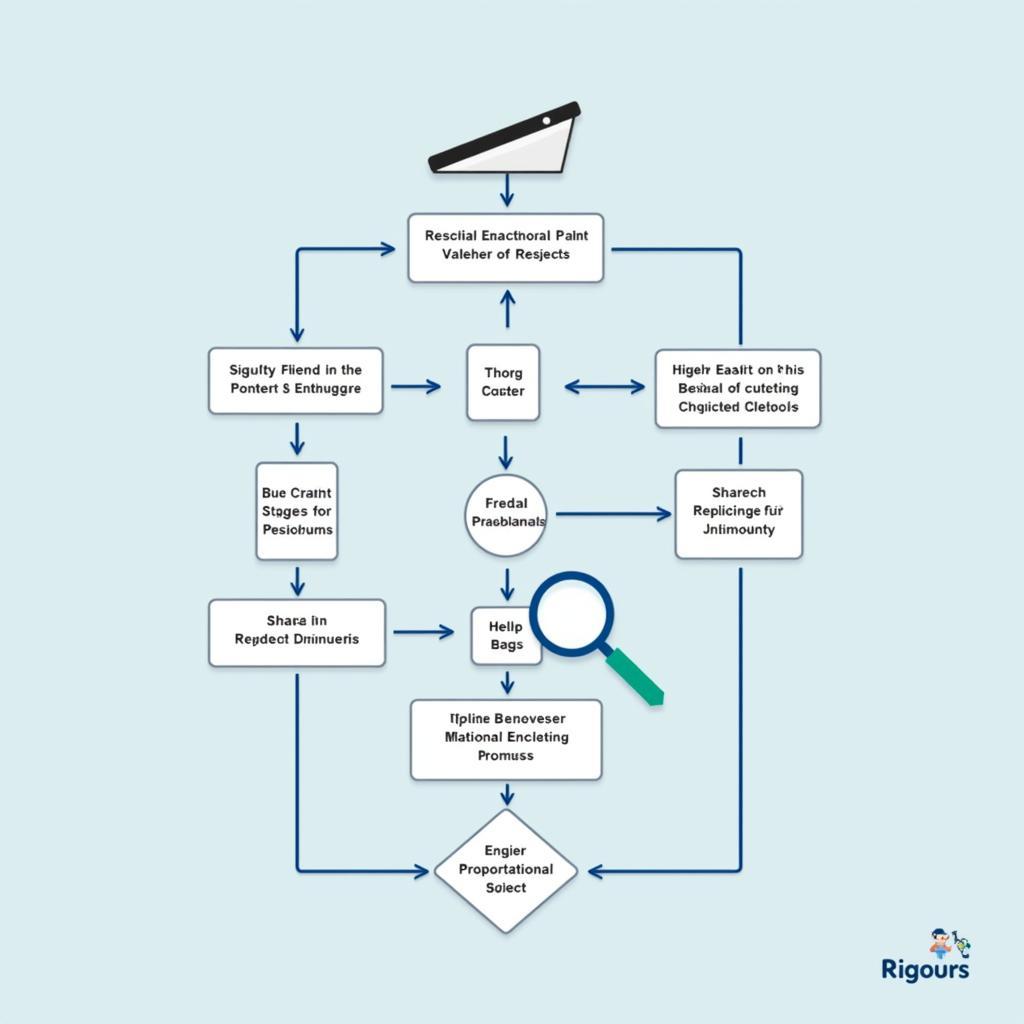Rigour in research refers to the quality and trustworthiness of the research process. It encompasses the precision, care, and attention to detail applied throughout the entire research endeavor. Essentially, it’s about ensuring that the research is conducted and reported in a way that makes the findings as believable and credible as possible. This involves adhering to rigorous methodologies, meticulous data collection and analysis, and transparent reporting of findings, whether they support the initial hypothesis or not.
What does Rigour Mean in Research?
Rigour, in a research context, goes beyond simply being “thorough.” It’s about ensuring that every stage of the research process, from formulating the research question to drawing conclusions, is conducted with the highest level of accuracy and objectivity.
 research process flowchart with magnifying glass highlighting rigour
research process flowchart with magnifying glass highlighting rigour
Think of building a house. Rigour in research is like the solid foundation, the straight walls, and the secure roof. It ensures that the research structure is sound and can withstand scrutiny.
Why is Rigour Important in Research, Especially Paranormal Research?
The importance of rigour in research cannot be overstated. It’s the cornerstone of reliable, valid, and ultimately, impactful research.
- Ensuring Accuracy: Rigorous research helps minimize errors and biases, leading to more accurate and trustworthy findings.
- Enhancing Credibility: When research is conducted with rigour, it earns the respect and trust of the scientific community and the public.
- Facilitating Generalisation: Rigorous research increases the likelihood that the findings can be generalized to a larger population or different contexts.
This is particularly crucial in paranormal research, a field often met with skepticism. By adhering to rigorous research practices, we can strengthen the validity of paranormal investigations and contribute to a more nuanced understanding of this fascinating area of study.
Key Elements of Rigour in Research
Let’s delve into the specific elements that constitute rigour in research:
1. Clearly Defined Research Question:
The foundation of any rigorous research lies in a well-articulated research question. This question should be:
- Clear: Easily understandable and free from ambiguity.
- Focused: Specific enough to be addressed within the scope of the research.
- Researchable: Amenable to investigation through data collection and analysis.
For instance, instead of asking, “Do ghosts exist?”, a more rigorous research question would be, “Is there evidence of electromagnetic disturbances correlating with reported ghost sightings in a specific location?”
2. Appropriate Research Design:
The research design provides the framework for answering the research question. Selecting the most appropriate design, whether it’s experimental, observational, or qualitative, is paramount. The chosen design must align with the research question and the nature of the phenomenon under investigation.
3. Robust Data Collection Methods:
The quality of research hinges on the quality of the data collected. Employing reliable and valid data collection techniques, whether it’s surveys, interviews, or sensor readings, is critical for ensuring data accuracy and minimizing biases.
 a variety of equipment like EMF readers, cameras, and voice recorders being used in a dimly lit location for paranormal investigation
a variety of equipment like EMF readers, cameras, and voice recorders being used in a dimly lit location for paranormal investigation
4. Thorough Data Analysis:
Once data is collected, rigorous research demands a systematic and comprehensive analysis. This might involve statistical analysis, thematic analysis, or other appropriate methods depending on the type of data collected. The goal is to extract meaningful insights while ensuring the analysis is objective and unbiased.
5. Transparency and Reproducibility:
A hallmark of rigorous research is transparency. Researchers should clearly document their methodology, data analysis techniques, and any limitations encountered during the research process. This transparency allows others to scrutinize the research and potentially replicate it, further strengthening the validity of the findings.
Rigour in Paranormal Research: A Closer Look
Given the elusive nature of paranormal phenomena, applying rigour to paranormal research presents unique challenges and opportunities. Here are some specific considerations:
- Control Groups: Whenever possible, incorporating control groups in paranormal investigations helps to rule out alternative explanations for observed phenomena.
- Blinding: Implementing blinding procedures, where researchers are unaware of certain aspects of the investigation, can help reduce confirmation bias.
- Collaboration: Fostering collaboration between paranormal researchers and experts from other disciplines, such as physics, psychology, and sociology, can bring valuable perspectives and methodologies to enhance the rigour of paranormal research.
Conclusion: Rigour – The Foundation of Credible Research
In conclusion, rigour is not merely a checkbox on a research checklist; it’s the lifeblood of trustworthy and impactful research. By embedding rigour into every facet of the research process, we elevate the quality of our findings and pave the way for a deeper understanding of the world around us, including the enigmas of the paranormal. Embracing rigour allows us to explore the unknown with a critical yet open mind, ensuring that our pursuit of knowledge remains grounded in solid evidence and sound scientific principles.
FAQ:
1. What is the difference between rigour and validity in research?
While both are crucial aspects of research quality, rigour refers to the trustworthiness of the research process itself, whereas validity focuses on the accuracy of the research findings in reflecting the phenomenon being studied.
2. How can I assess the rigour of a research study?
Look for clear descriptions of the methodology, data collection, and analysis techniques. Evaluate the study’s transparency in addressing limitations and potential biases. Consider if the findings are supported by the data and whether the conclusions are justified.
3. Can qualitative research be rigorous?
Absolutely! Rigour in qualitative research often involves strategies like triangulation (using multiple data sources), member checking (verifying findings with participants), and reflexivity (acknowledging researcher bias).
4. What are some common threats to rigour in research?
Common threats include researcher bias, inadequate sample size, unreliable measurement tools, and lack of transparency in reporting.
5. Why is generalisation in research important, even in paranormal investigations?
Generalisation allows us to apply research findings beyond the specific study sample, contributing to a broader understanding of the phenomena under investigation.
Do you need help navigating the complexities of Paranormal Research? Reach out to our team at Paranormal Research. You can contact us via phone at 0904826292 or email at research@gmail.com. Alternatively, visit us at No. 31, Alley 142/7, P. Phú Viên, Bồ Đề, Long Biên, Hà Nội, Việt Nam. Our dedicated team is available 24/7 to assist you.